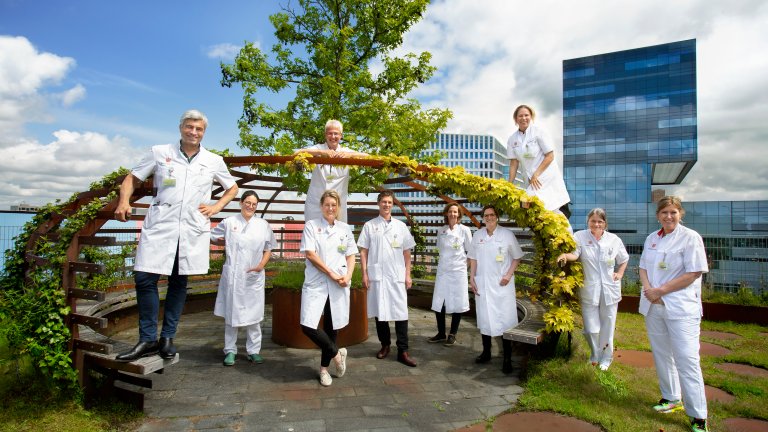Following the establishment of Amsterdam UMC in 2018, the blending of different medical departments at locations AMC and VUmc has been conducted in several carefully planned phases. Amsterdam UMC is the largest center in the Netherlands - and one of the largest in Europe - in the treatment of esophageal and gastric cancer, performing complex surgeries on more than 250 patients annually.
Improving complex care
“Patients with these tumors need complex care,” says Surgeon Mark van Berge Henegouwen, Professor of Gastrointestinal Surgery. “There are many medical professionals involved in the treatment before, during, and after surgery. Almost all of these patients receive chemotherapy, radiation, or a combination of both, prior to surgery. This requires an intensive collaboration of medical experts from nurses, dieticians, anesthetists to surgeons.
The surgical procedures are also technically demanding. For example, during an esophageal operation you may have to operate in the abdomen, in the chest, and also in the neck. This increases the risks of complications. However, the more often you perform such an operation, the more experience and skills you and your team gains. The benefit of the centralization is that we will see more patients and can therefore achieve better care results.”
Maintaining high care standards
Prof. van Berge Henegouwen was concerned about the move, partly because in the beginning there was uncertainty about how many and which colleagues from the care pathway could move as well. “How do you organize this move without jeopardizing patient care? That was our top priority. In previous years, we had made good progress in improving care for patients with fewer complications as a result. Obviously, we wanted to maintain the highest care standards. But how do you organize that when blending organizations?”
Preparation, preparation, preparation
“In the run-up to the move, we did an incredible amount of work in preparation. This preliminary work was essential for a flawless execution. Many different people contributed with insights and advice to map out all possible scenarios in advance, to draw up protocols, to indicate which colleagues had essential roles, and to determine if these professionals could move at all.”
Good Reception
“Settling into our new location, everyone just made us feel very welcome, not only within our department, but all departments at location VUmc. Of course there were differences, but you have to handle these flexibly. Merging only works if you do not focus on the differences, but rather on the similarities and the common goals. We had to get used to working at the VUmc location, but the colleagues here also had to get used to us. That is just part of it. The most important thing is that everyone has been very open to this. You have new people to work with, you have to invest in new connections, that is essential to be successful.”
Reducing length of hospital stay
Prof. Van Berge Henegouwen emphasizes the importance of the ‘care path’ for achieving the best clinical results. A care path provides a clearly defined step-by-step treatment protocol for patients to minimize variations in clinical practice, thereby improving the quality of care and efficiency. ”Our care provisions start at the moment the patients arrives and every step is precisely planned, right up until the moment that the patient goes home about a week later.”
During the merger, the physician assistants, whom the patients see every day, were crucial for ensuring implementation of the care path. Now, Amsterdam UMC has one of the shortest hospital length of stay for these patients in the Netherlands. This is a very important achievement, especially during the pandemic when hospital beds are in high demand.
Progress for patients
Now that the merger is complete, what are the results? “We have now operated on more than 200 patients at our new location and the results are very good,” says Prof. Van Berge Henegouwen. For example, ‘anastomotic leakage,’ a leak that can occur after tumor removal and reconstruction of the gastrointestinal tract, is a potential serious complication for the patient. “With the help of technical innovations, we have been able to reduce the incidence of this complication from previously 1 in 10 patients to now 1 in 20. That is a major improvement.”
Continuing improvements
And what is next? “We want to continue to improve and we are doing this by constantly analyzing our results to find areas for improvement. Thanks to the Cancer Center Amsterdam Foundation, we now have two very advanced surgical robots: the ‘Da Vinci Xi’ in this location. This, in turn, gives a new impulse to innovation and care improvement. Also, we have new regional partnerships and our successful care path is being implemented at other hospitals. In addition, more and more complex patients with esophageal or gastric cancer are being referred to our center, first regionally, but also nationally. We are already seeing an increase in complex patients, and I am confident we have the right team at the right location to give these patients the best care possible.”
This is only part of the multidisciplinary esophageal and gastric cancer expert team:

[Credit] Text by Henri van de Vrugt

